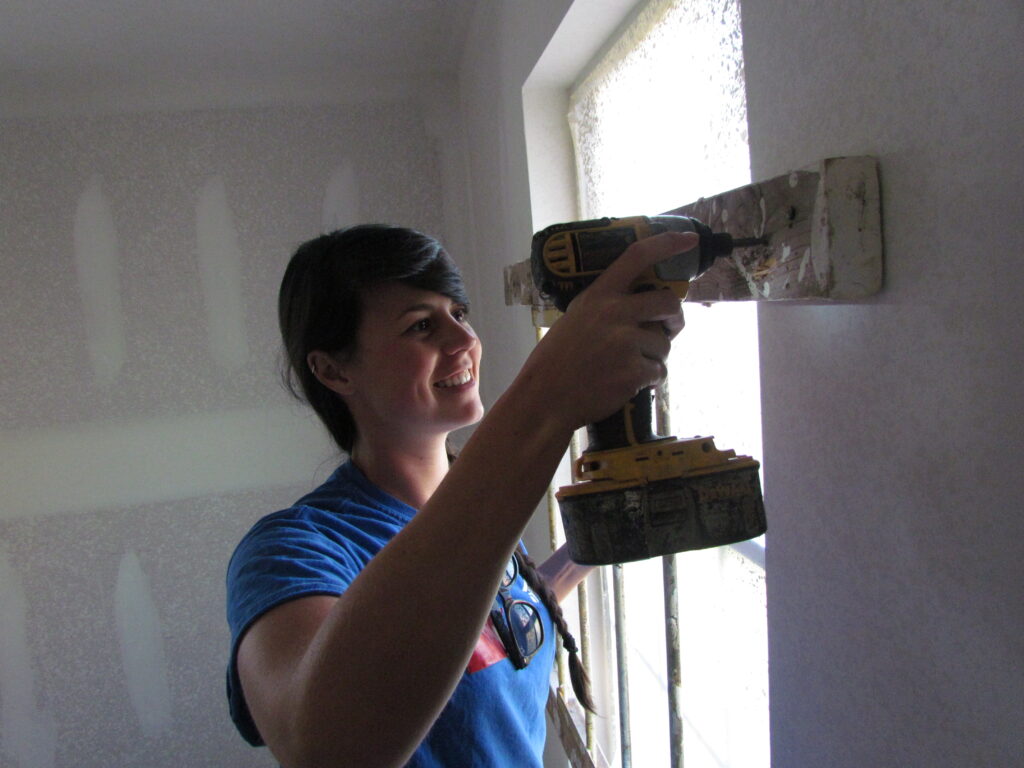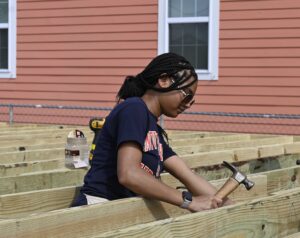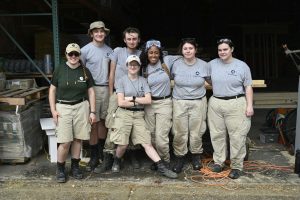
Kelsie Renehan started working with Habitat for Humanity 10 years ago. As a teenager, she went with her church on a build, and that first day, she knew she wanted Habitat to be part of her life.
“The first day, I went out there, I came back, and I knew,” Kelsie said. “I was gonna do this for as long as I possibly could. I actually stuck to it. It was rewarding work, and I liked being sore at the end of the day not because I did meaningless exercise, but because I was working toward something that would help someone else. I was young, so I didn’t have the worldview or education that I have now. I believe that shelter is a human right.”
Her first trip was to Garrett County, MD, a smaller community in Appalachia. When she first started, her group had many skilled workers who were able to do some of the more complicated parts of the build, so Kelsie immediately began gaining experience with foundation work and roofing, among other parts of home construction.
“Every time we went out, we would do the foundation, the masonry, the roof, the porches,” she said. “I did it for a few more summers. They were week long trips.”
From that first day, she began volunteering regularly. At college, she was part of her campus chapter of Habitat. At the campus chapter at the University of Maryland College Park, after spending a year working on fundraising, Kelsie ran for co-president and won. She led several student volunteer trips, where she used her experiences with Habitat to help teach–and inspire–the other students.
“My favorite part when I worked with the Baltimore Habitat with my college,” she said, “because we would take a lot of people out on their first Habitat trip ever. It’d be freshmen and sophomore girls. Women are conditioned to think that they probably can’t lift anything heavy. It was so cool to watch these 18 year old women realize how strong they really were. They’d think, ‘I can’t carry this generator up the steps.’ I’d tell them, ‘No, you can do it.’ At the end of the day, they’d be sleeping in the back of the car, but they rocked it the whole day. You could see their confidence pick up over the course of the day, just continue to be more confident in their strength. They’re just as committed, just as strong, just as intelligent.”

In May, NOAHH will hold its second annual Women Build, where hundreds of women will come together to help build two homes for hard working New Orleans women and their families. Kelsie is part of the tradition at NOAHH of women who lead and build to support their community. Working in New Orleans East near last year’s Women Build site inspires her, and she enthusiastically spreads the word about the build. Her history of inspiring other women on the work site has continued at Habitat–and been shared by other AmeriCorps. Claudia Smolinski is one of Kelsie’s fellow AmeriCorps members and her roommate.
“We had a group of high school girls from Mt. Carmel Academy,” said Claudia, “and two of them dug out a whole driveway. They were just all about it. They had fun. It started pouring [rain] one day, and nothing stopped them. We had a rain plan, but they said, ‘Why would we do that? We can dig. It’s fine.’ They were very upbeat. They believed in themselves. It was me and [AmeriCorps] Danielle leading the site. I remember turning to Danielle and saying, ‘This is so exciting for us to be the only construction crew they see at Habitat, because they can believe in themselves. It doesn’t matter what society may think. Everyone’s strong.'”
“We had them come to Villere when I was working there,” Kelsie said. “They were doing the same thing where they were digging out and leveling the yard. Then they were putting sod down. They were so on top of it, and they were so high-spirited.”
Kelsie fell in love with New Orleans on a trip during her senior year in college. She and her friends were halfway to the city from Baltimore when the owner of their hotel told them it was haunted–much to their surprise and trepidation. Though they didn’t see any ghosts, it set the tone for the trip. They visited many of the city’s most well known locations–the French Quarter, Magazine Street, Audubon Park–and Kelsie knew she wanted to come back some day
“We loved the people,” she said. “We loved that there were so many oak trees and Spanish moss. I’m a warm weather person for sure. Keeping it warm year round is nice.”
Working with Habitat in Baltimore, there were times when the weather was less inviting. One memorable build found snow coming in through open windows while they worked inside.
“It was snowing into the house while we were framing,” she said. “So I thought, ‘If I can build in that, I can build in anything, even if it does get cold down here.'”
When she graduated, she moved to Philadelphia. After a year living there, she decided to join AmeriCorps in New Orleans.
“I knew I loved Habitat because I’ve been working with Habitat since 2008,” she said, “and I knew I loved New Orleans. It made an easy choice because I get to continue my service for a tenth year with the organization. I loved it [in Philadelphia], but I knew I had to do this. If I didn’t do it now, when would I? It was a great decision.”

Her first week on site with NOAHH was in August 2017, when snow was the last thing on any New Orleanian’s mind.
“I like the heat,” she said. “I don’t mind it. It was lovely to be working in warm weather, and we were doing some heavy lifting in the first week. It was good to get right back into it. And even though I’ve been doing Habitat for a while, in the first week, I did a lot of stuff I’ve never done before, because so often I’ve been doing the big heavy parts of the house.”
One of the first jobs she had on site highlighted differences between Habitat affiliates and the styles of homes built around the country. When she learned she was going to be putting up siding, her first reaction was dismay, because her experiences with siding had been with sharp-edged vinyl siding. Instead, NOAHH uses Hardie Board siding to help protect the home from hurricanes. She also reflected on other differences between affiliates, noting that in Garrett County, the homes are built with bricks instead of up on stilts. NOAHH offers more options for areas of the city where homeowners can pick their lots. NOAHH has a rental program for those who aren’t yet financially stable enough to qualify for our homeownership program, as part of our efforts to expand access to affordable housing in the city.
“The people going into the rentals are sometimes future homeowners,” she said. “I also love that we work with organizations like the Mission, because they also strive to provide shelter to people. In times when it’s cold, they have freeze nights, and they open up the entire floor and set up cots. They’re very committed to serving the community as well. It’s cool that we can partner with them and help with some of their Discipleship job programs to get them more avenues for success.”
There are many similarities as well. Most Habitat affiliates follow similar models for our homeownership programs. And in Baltimore, in one neighborhood, there are homes that have another New Orleans quality to them: “Those houses were fun because they were colors like New Orleans houses. They were bright, and they were town houses, like Baltimore usually is.”
Other than learning new construction skills on site, Kelsie has also learned skills she will take with her into other fields.
“This year has taught me a lot of skills that I’ll continue to use,” she said. “I think developing leadership skills is very tough. It’s taken me a long time, and I’m actually a shy person. I have had to work to develop leadership skills. I think I’ve gotten a little better, hopefully. One of my goals at the beginning of the [service] year was to become more effortless seeming in my leadership. I get to work and live with [AmeriCorps members] Claudia, Mampy, and Danielle. They all have unique perspectives on leadership, and developed ones that they’ve gotten from classes, coaching, being a college athlete. It’s all been valuable to learn and enact in my daily life. Everyone here constantly inspires me to be a better person. And to keep working on myself and to keep working for others.”

On site, guiding volunteers means juggling several tasks at once. Volunteers are crucial to Habitat’s home-building, and their ability to do multiple tasks at once makes the build quicker and more efficient. AmeriCorps and staff members help train and lead them. Kelsie cites this skill as what makes her feel most accomplished as a leader.
“You have a volunteer group of 15 people,” she said, “and since we’re doing finishing work, they all have small jobs to do. They’re all doing different jobs. I am going to train seven different groups of people on seven different jobs. When there’s two people doing that, it’s a lot of running around. I would say that’s probably the best part. And giving the speech in the morning. it is something that makes me feel like a good leader. I love talking about Habitat.”
She takes her inspiration from a notable citizen of Philadelphia.
“I read this quote,” she said, “and I’ve been writing on the houses. Ben Franklin used to live by the motto, ‘What good am I going to do on this day?’ I’ve been trying to think about what good I am going to do on this day. So I’ve been writing it on the houses. I think it’s a good thing to keep in mind.”
After her first week on site, she continued learning new construction skills, but early on in her year of service, she found herself in a very different kind of build experience: Unity Build, an accelerated build where 11 local congregations came together to build a home in 12 days.
“We had a great team and a great leader,” she said. “[Site supervisor] Tim was efficient. He’s kind. He’s very democratic. He’s a great teacher. We had a good group of AmeriCorps. We were all about getting the lay of the land, and if there was something that someone else knew how to do, we just kept moving. It was great both to have days where we set up for volunteers and when we had 30 volunteers on site, and we were all running around and having a great time.”
Working at Unity Build meant getting to work closely with Nicole, the Unity Build homeowner, who came out every day. According to Claudia, she was dedicated to building her own home: “She was there every step of the way and would do anything. I asked what her least favorite part of it was, and she said painting or scraping paint. But she would do it anyway. ‘It had to be done,’ she said. She had that attitude. ‘I’m no better than anyone else.'”
“We got to work with Nicole,” said Kelsie, “and we developed relationships with some of the volunteers that kept coming back. It was so rewarding to see the house go up that quick. When we did the walkthrough, there wasn’t that much that needed to be done, because it was all done right after the other. All of us loved Unity Build so much. We were just delighted to all be working on that house. The dedication ceremony was so emotional. It was incredible because so many people came out to that dedication, because so many people had worked on that house. They were invested in it. I was working on Nicole’s house doing touch up later, and one of the volunteers rolled by with his wife. He wanted to show her the house, hoping to meet Nicole and her family. I love how invested people are in both the family and the house. You could ask for a better partner family than Nicole. She’s incredibly kind.”

For Kelsie, part of what she loves about working at Habitat is the people she meets.
“Everyone I’ve met through Habitat is an absolute joy,” she said, “because most of the time, people want to be there. They signed up for the house-building project, or they donated money, or they work here, or they’re here with their schools. It really makes a difference, because you meet people who want to better their community. It’s good to see people doing good. It’s good to be given the opportunity to work with our homeowners.”
Kelsie’s first interactions with partner families were years ago in Garrett County.
“In Garrett County, since all the houses are in the same neighborhood, you get to see the houses you worked on the year before,” she said, “and the families that live in them. There were these three kids that would just ride around on their bikes near our work sites and ‘terrorize’ us. They were so funny. They would climb on us. It was so cute. They were great. That was my first homeowner experience.”
In New Orleans, she has built stronger relationships with the homeowners with whom she works day to day.
“Antonia [Hall] has six kids, so she had a floor plan that was the biggest one we have,” she said. “I still keep in contact with her. She’s painting the kids’ rooms. They look so cute. Yesterday, she was saying how everyone was off work, but they were there, making bunk beds. Not a day off for her! She was sanding and painting a dresser for her kids. It’s good working with homeowners. You hear all of their ideas for how they’re gonna make the house theirs later.”
Getting to know partner families and working with different Habitat affiliates for ten years has given Kelsie perspective on Habitat’s program. NOAHH’s homeownership has three requirements: ability to pay, need for shelter, and willingness to partner. When they join the program, they work volunteer hours (with help from friends and family) in lieu of a financial down payment. These volunteer hours are in the ReStore and on the build site, giving them many opportunities to work with volunteers and interact with the community. They do not get their home for free, but buy it with a 0% interest mortgage with a monthly payment that is less than 30% of their income. Part of being a leader on site, for Kelsie, is talking to people about the program.
“It’s good that our homeowners are building equity,” she said. “That’s very beneficial. I like that the program is set up for homeowners to succeed and for people to get to know who they’re building with, and hopefully to align people’s views a little bit more with what families look like that are in need of decent shelter. I think a lot of misconceptions people have about people who live in low-income housing is that they don’t work as hard. As soon as you start talking about how our homeowners put in sweat equity as a down payment and that they work hard financially and how they qualify for the program, and what the local rent culture is like, it makes a difference. I’ve had talks with volunteers over lunch where we were talking about people who qualify and what requirements they have to fill. They thought Middle Americans were left out of this population, but actually we serve people between 30 and 80% median income.”

Now, halfway through her term here, she has taken part in a blitz build, learned new skills, and made close friends, from the partner families, the volunteers, and her fellow AmeriCorps members.
“Programs like this where you get thrown together with ten people that you didn’t know before,” she said, “but you live with them, you work with them, you continue to hang out with them in the evenings, it makes you close really fast.”




